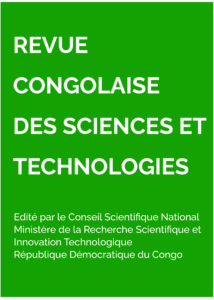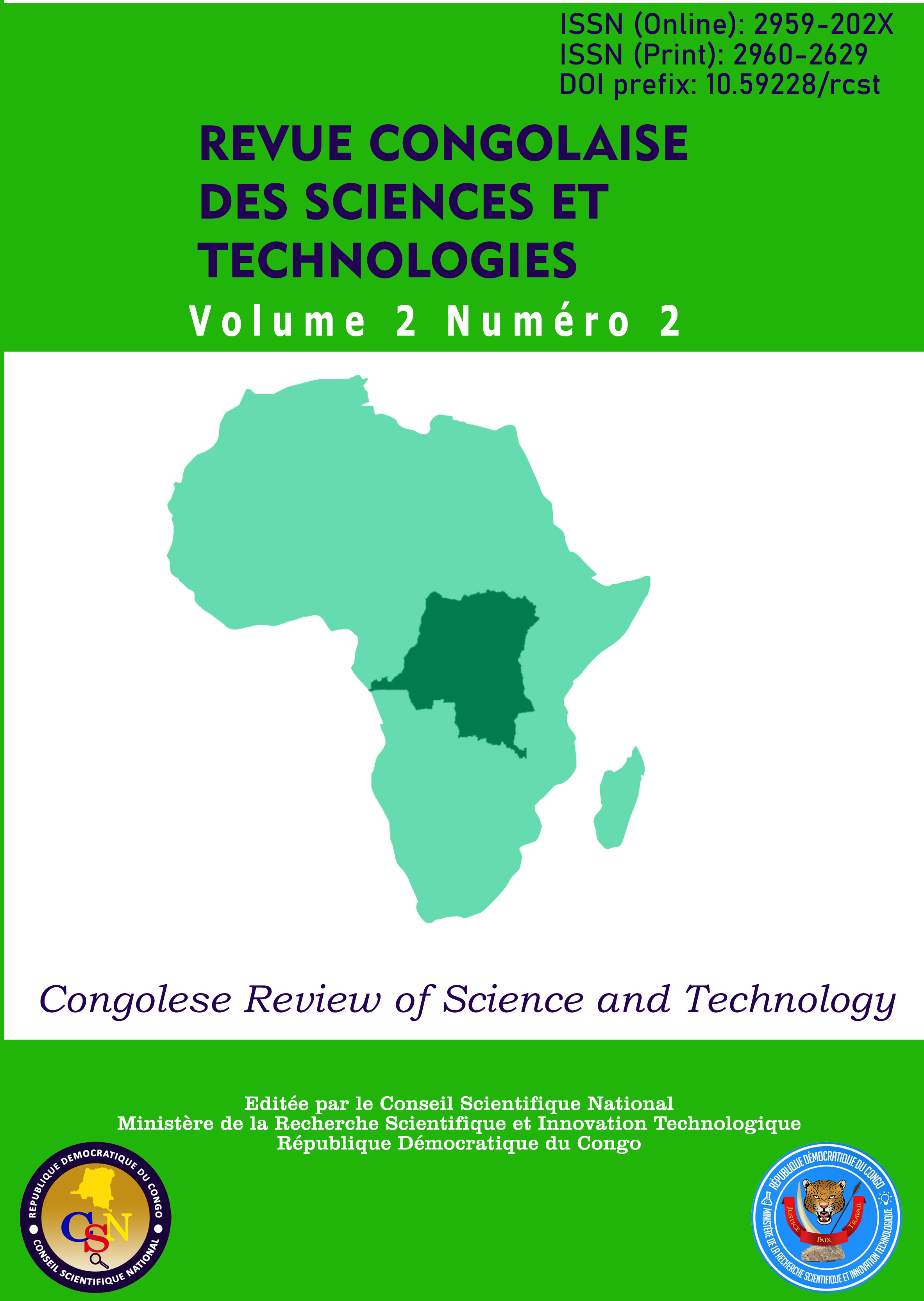Ethnobotanical survey on medicinal plants used in the Ebola river basin (Abumombazi Forest Reserve) in the Democratic Republic of Congo
Main Article Content
Abstract
The aim of this study was to inventory the medicinal plants used in the Ebola River basin in the Democratic Republic of
Congo. The majority (81.8%) of respondents were men (vs. 18.2% of women). The majority (52.9%) of respondents had
secondary education; 29.8% had primary education and almost 1.0% (0.8%) had university education. 41.3% of the
respondents are between 31-45 years of age; 29.8% of the respondents are between 18-30 years of age, 25.6% are over 45
years of age and 3.3% of the respondents are under 18 years of age. 82.6% of the respondents are married, while 17.4% are
single. For 48.8% of respondents, the household size is 5-10 persons. 38.0% have a household size of less than 5 persons,
8.3% of households have between 11-15 persons and 5.0% of households have more than 15 persons. 32 plant species (of
which five have not yet been identified) have been recorded and belong to 26 genera and 19 families. The main parts used are
the leaf (40.6%) and the root (31.3%). 96.9% of respondents use the drug in a fresh state, while only 3.1% use it in a dry state.
General pain, sexual weakness, back pain and tooth decay are the main illnesses treated by these medicinal plants. 90.6% of
the respondents believe that the patients get better after the treatment. Apart from their medicinal role, the plants inventoried
are also used in the area as fuel wood or timber. The identification of forest resources as well as their valorization and
protection is becoming an imperative duty in North Ubangi in order to contribute to its sustainable development strategies.
Article Details

This work is licensed under a Creative Commons Attribution-NonCommercial-ShareAlike 4.0 International License.
References
Alalwan T. A., Alkhuzai J. A., Jameel Z., Mandeel
Q. A. (2019). Quantitative ethnobotanical
study of some medicinal plants used by
herbalists in Bahrain. Journal of Herbal
Medicine, 17-18: 100278.
https://doi.org/10.1016/j.hermed.2019.100278
Amjad M. S., Qaeem M. F., Ahmad I., Khan S. U.,
Chaudhari S. K., Zhaid M. N., et al., (2017).
Descriptive study of plant resources in the
context of the ethnomedicinal relevance of
indigenous flora: A case study from Toli Peer
National Park, Azad Jammu and Kashmir,
Pakistan. PLoS ONE, 12 (2): e0171896.
https://doi.org/10.1371/journal.pone.0171896
Amujoyegbe O.O., Idu M., Agbedahunsi J.M.,
Erhabor J.O. (2016). Ethnomedicinal survey
of medicinal plants used in the management of
sickle cell disorder in Southern Nigeria.
Journal of Ethnopharmacology, 185 : 347-
https://doi.org/10.1016/j.jep.2016.03.042
APG (Angiosperm Phylogeny Group) III. 2009. An
update of the Angiosperm Phylogeny Group
classification for the orders and families of
flowering plants. APG III. Botanical Journal
of the Linnean Society 161: 105–
https://doi.org/10.1111/j.1095-
2009.01000.x
Asimonyio J.A., Ngabu J.C., Lomba C.B., Falanga
C.M., Mpiana P.T., Ngbolua K.N. (2015).
Structure et diversité d’un peuplement
forestier hétérogène dans le bloc sud de la
réserve forestière de Yoko (Ubundu,
République Démocratique du Congo).
International Journal of Innovation and
Scientific Research, 18: 241-251.
Faruque M. O., Feng G., Khan Md. N. A., Barlow J.
W., Ankhi U R.., Hu S., et al. (2019).
Qualitative and quantitative ethnobotanical
study of the Pangkhua community in
Bilaichari Upazilla, Rangamati District,
Bangladesh. Journal of Ethnobiology and
Ethnomedicine, 15: 8.
https://doi.org/10.1186/s13002-019-0287-2
Ilumbe Bayeli G., 2010. Utilisation des plantes en
médecine traditionnelle par les Pygmées (BaTwa) et les Bantous (Ba-Oto) du territoire de
Bikoro, Province de l’Équateur en République
Démocratique du Congo. Thèse de doctorat,
Université libre de Bruxelles, Belgique.
https://difusion.ulb.ac.be/vufind/Record/ULB
DIPOT:oai:dipot.ulb.ac.be:2013/210007/TOC
Junsongduang A., W. Kasemwan, S. Lumjoomjung,
W. Sabprachai, W. Tanming and H. Balslev.
Ethnomedicinal Knowledge of
Traditional Healers in Roi Et, Thailand.
Plants, 9: 1177.
https://doi.org/10.3390/plants9091177
Kambale J.-L.K., Asimonyio J.A., Shutsha R.E.,
Katembo E.W., Tsongo J.M., Kavira P.K.,
Yokana E.I., Bukasa K.K., Nshimba H.S.,
Mpiana P.T., Ngbolua K.N. (2016a). Études
floristique et structurale des forêts dans le
domaine de chasse de Rubi-Télé (Province de
Bas-Uélé, République Démocratique du
Congo). International Journal of Innovation
and Scientific Research, 24 : 309-32.
Kambale J.-L.K., Shutsha R.E., Katembo E.W.,
Omatoko J.M., Kirongozi F.B., Basa O.D.,
Bugentho E.P., Yokana E.I., Bukasa K.K., Nshimba H.S., Ngbolua K.N. (2016b). Étude
floristique et structurale de deux groupements
végétaux mixtes sur terre hydromorphe et
ferme de la forêt de Kponyo (Province du
Bas-Uélé, R.D. Congo). International Journal
of Innovation and Scientific Research, 24:
-308.
Kumar P., Lalramnghinglova H. 2011. India with
special reference to an Indo Burma hotspot
region. Ethnobotany Research & Applications,
-420. https://doi.org/10.
/era.9.0.379-420
Lautenschläger T., Monizi M., Pedro M., Mandombe
J.L., Bránquima M.F., Heinze C., Neinhuis C.
(2018). First large-scale ethnobotanical survey
in the province of Uíge, northern
Angola. Journal of Ethnobiology and
Ethnomedicine, 14: 51.
https://doi.org/10.1186/s13002-018-0238-3.
Mongeke M.M., Ngbolua K.N., Bakola R.D., Inkoto
C.L., Elikandani P.N., Mowuli C.Y. (2018).
Survey on the plants used in Traditional
medicine by Bambenga: Pygmy from Dongo
Sector (Territory of Kungu, Province of SudUbangi) in Democratic Republic of the
Congo. Revue Marocaine des Sciences
Agronomiques & Vétérinaires, 6 (4): 469-475.
Ngbolua K.N., Rafatro H., Rakotoarimanana H.,
Urverg R.S., Mudogo V., Mpiana P.T.,
Tshibangu D.S.T. (2011a). Pharmacological
screening of some traditionally-used
antimalarial plants from the Democratic
Republic of Congo compared to its ecological
taxonomic equivalence in Madagascar.
International Journal of Biological
and Chemical Sciences, 5: 1797-1804.
Ngbolua K.N., Rakotoarimanana H., Rafatro H.,
Urverg S.R., Mudogo V., Mpiana P.T.,
Tshibangu D.S.T. (2011b). Comparative
antimalarial and cytotoxic activities of two
Vernonia species: V. amygdalina from the
Democratic Republic of Congo and V. cinerea
subsp vialis endemic to Madagascar.
International Journal of
Biological and Chemical Sciences, 5: 345-
Ngbolua K.N., Benamambote B.M., Mpiana P.T.,
Muanda D.M, Ekutsu E.G., Tshibangu D.S.T.,
Gbolo B.Z., Muanyishay C.L., Basosila N.B.,
Bongo G.N., Robijaona B. (2013a). Ethnobotanical survey and Ecological Study of
some Medicinal Plants species traditionally
used in the District of Bas-Fleuve (Bas-Congo
Province, Democratic Republic of Congo).
Research Journal of Chemistry, 1: 01-10.
Ngbolua K.N., Mpiana P.T., Mudogo V., Ngombe
N.K., Tshibangu D.S.T., Ekutsu E.G., Kabena
O.N., Gbolo B.Z., Muanyishay L. (2014a).
Ethno-pharmacological survey and Floristical
study of some Medicinal Plants traditionally
used to treat infectious and parasitic
pathologies in the Democratic Republic of
Congo. International Journal of Medicinal
Plants, 106: 454-467.
Ngbolua K.N. (2018). Données préliminaires sur la
biodiversité du Nord-Ubangi en République
démocratique du Congo. Editions
Universitaires Européennes, Riga : Latvia.
ISBN : 978-613-8-44529-6.
Ngbolua K.N. (2020). Quantitative ethnobotany:
Methodological approach for the evaluation
and valorization of endogenous knowledge
in tropical regions. Sciancia Scripts
Publisher: Mauritius. ISBN: 978-620-2-
-2.
Ong H.G., Kim Y.D. 2020. Medicinal plants for
gastrointestinal diseases among the Kuki-Chin
ethnolinguistic groups across Bangladesh,
India, and Myanmar: a comparative and
network analysis study. Journal of
Ethnopharmacology, 251:112415.
https://doi.org/10.1016/j.jep.2019.112415.
Pathy K.K, Flavien N. B., Honoré BK, W. Vanhove,
P. Van Damme. (2021). Ethnobotanical
characterization of medicinal plants used in
Kisantu and Mbanza-Ngungu territories,
Kongo-Central Province in DR Congo.
Journal of Ethnobiology and Ethnomedicine,
:5. https://doi.org/10.1186/s13002-020-
-7.
Ribeiro R.V., Bieski I.G.C., Balogun S.O., Martins
D.T.O. (2017). Ethnobotanical study of
medicinal plants used by Ribeirinhos in the
North Araguaia microregion, Mato Grosso,
Brazil. Journal of Ethnopharmacology, 205 :
-102.
https://doi.org/10.1016/j.jep.2017.04.023.
Rusaati B. I. W., Gendusa A. P., Joo S. H., Park J.
W., Masumbuko N. C., Iragi K. G., Ngbolua
K.-T.-N., Furaha M. A., Rolly N. K., Kang J.
W. (2021). A systematic review of
antimalarial medicinal plants in Democratic
Republic of the Congo. Bois et Forêts des
Tropiques, 347 : 11-27.
https:/doi.org/10.19182/bft2021.347.a31882.
Srithi K., Balslev H., Wangpakapattanawong P.,
Srisanga P., Trisonthi C. (2009). Medicinal
plant knowledge and its erosion among the
Mien (Yao) in northern Thailand. Journal of
Ethnopharmacology, 123(2): 335-42.
https://doi.org/10.1016/j.jep.2009.02.035
Umair M., Altaf M., Bussmann R. W., Abbasi A. M.
(2019). Ethnomedicinal uses of local flora in
Chenab riverine area, Punjab province,
Pakistan. Journal of Ethnobiology and
Ethnomedicine, 15: 7.
https://doi.org/10.1186/s13002-019-0285-4.
World Health Organization (2002). Traditional
medicine strategy 2002-2005.
http://www.who.int/medicines/library/trm trat
eng.pdf .

